View in other NatureServe Network Field Guides
NatureServe
Montana
Utah
Wyoming
Idaho
Wisconsin
British Columbia
South Carolina
Yukon
California
New York
Red-osier Dogwood - Cornus sericea
Other Names:
Cornus stolonifera, Cornus alba
Native Species
Global Rank:
G5
State Rank:
S5
C-value:
5
Agency Status
USFWS:
USFS:
BLM:
External Links
General Description
Branching shrubs to 3 m. Twigs reddish, strigose at first becoming glaucous and then glabrous. Herbage sparsely strigose. Leaves petiolate; the blades pale beneath, 3–15 cm long with acuminate tips. Inflorescence a flat-topped compound cyme 3–10 cm across. Flowers: hypanthium 1–2 mm long; petals 2–4 mm long. Drupe white to bluish, 1-seeded, 5–7 mm long (
Lesica et al. 2012. Manual of Montana Vascular Plants. BRIT Press. Fort Worth, TX).
Our plants are subspecies
sericea.
Species Range
Montana Range
Range Descriptions
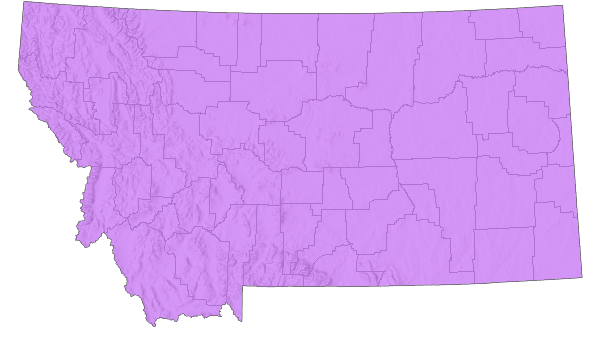
 Native
Native
Range Comments
Cornus sericea is native to North America and occurs along shores and in thickets from Newfoundland and S. Labrador west to Ohio, Indiana, Illinois, Iowa, Nebraska, and south to New Mexico, Arizona and California (Fernald 1950).
Observations in Montana Natural Heritage Program Database
Number of Observations: 2697
(Click on the following maps and charts to see full sized version)
Map Help and Descriptions
Relative Density
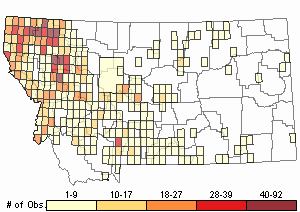
Recency
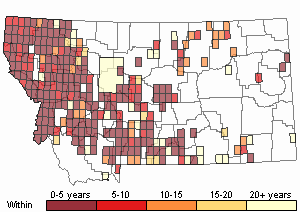
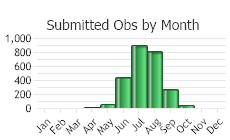
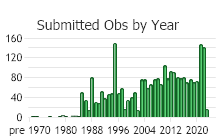
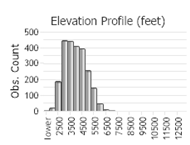 (Observations spanning multiple months or years are excluded from time charts)
(Observations spanning multiple months or years are excluded from time charts)
Habitat
Moist forest, thickets, especially along streams, avalanche slopes; plains, valleys to montane (
Lesica et al. 2012. Manual of Montana Vascular Plants. BRIT Press. Fort Worth, TX).
National Vegetation Classification System Groups Associated with this Species
Forest and Woodland
Deciduous Forest and Woodland
Wetland and Riparian
Riparian and Wetland Forest
Riparian Shrubland
Wet Meadow and Marsh
Ecology
POLLINATORS The following animal species have been reported as pollinators of this plant species or its genus where their geographic ranges overlap:
Bombus vagans,
Bombus pensylvanicus, and
Bombus griseocollis (Colla and Dumesh 2010, Williams et al. 2014).
Stewardship Responsibility
References
- Literature Cited AboveLegend:
 View Online Publication
View Online Publication Colla, S.R. and S. Dumesh. 2010. The bumble bees of southern Ontario: notes on natural history and distribution. Journal of the Entomological Society of Ontario 141:39-68.
Colla, S.R. and S. Dumesh. 2010. The bumble bees of southern Ontario: notes on natural history and distribution. Journal of the Entomological Society of Ontario 141:39-68. Lesica, P., M.T. Lavin, and P.F. Stickney. 2012. Manual of Montana Vascular Plants. Fort Worth, TX: BRIT Press. viii + 771 p.
Lesica, P., M.T. Lavin, and P.F. Stickney. 2012. Manual of Montana Vascular Plants. Fort Worth, TX: BRIT Press. viii + 771 p. Williams, P., R. Thorp, L. Richardson, and S. Colla. 2014. Bumble Bees of North America. Princeton, NJ: Princeton University Press. 208 p.
Williams, P., R. Thorp, L. Richardson, and S. Colla. 2014. Bumble Bees of North America. Princeton, NJ: Princeton University Press. 208 p.
- Additional ReferencesLegend:
 View Online Publication
View Online Publication
Do you know of a citation we're missing? Boggs, K. W. 1984. Succession in riparian communities of the lower Yellowstone River, Montana. M.S. Thesis. Montana State University, Bozeman, 107 pp.
Boggs, K. W. 1984. Succession in riparian communities of the lower Yellowstone River, Montana. M.S. Thesis. Montana State University, Bozeman, 107 pp. Cope, M.G. 1992. Distribution, habitat selection and survival of transplanted Columbian Sharp-tailed Grouse (Tympanuchus phasianellus columbianus) in the Tobacco Valley, Montana. M.Sc. Thesis. Bozeman, Montana: Montana State University. 60 p.
Cope, M.G. 1992. Distribution, habitat selection and survival of transplanted Columbian Sharp-tailed Grouse (Tympanuchus phasianellus columbianus) in the Tobacco Valley, Montana. M.Sc. Thesis. Bozeman, Montana: Montana State University. 60 p. Culver, D.R. 1994. Floristic analysis of the Centennial Region, Montana. M.Sc. Thesis. Montana State University, Bozeman. 199 pp.
Culver, D.R. 1994. Floristic analysis of the Centennial Region, Montana. M.Sc. Thesis. Montana State University, Bozeman. 199 pp. Dresser, M.A. 2015. Demographic responses of woodpeckers in relation to a Mountain Pine Beetle epidemic in the Elkhorn Mountains of Montana. M.Sc. Thesis. Bozeman, MT: Montana State University. 71 p.
Dresser, M.A. 2015. Demographic responses of woodpeckers in relation to a Mountain Pine Beetle epidemic in the Elkhorn Mountains of Montana. M.Sc. Thesis. Bozeman, MT: Montana State University. 71 p. DuBois, K.L. 1979. An inventory of the avifauna in the Long Pines of Southeastern Montana. M.Sc. Thesis. Bozeman, MT: Montana State University. 113 p.
DuBois, K.L. 1979. An inventory of the avifauna in the Long Pines of Southeastern Montana. M.Sc. Thesis. Bozeman, MT: Montana State University. 113 p. Eggers, M.J.S. 2005. Riparian vegetation of the Montana Yellowstone and cattle grazing impacts thereon. M.Sc. Thesis. Montana State University, Bozeman, MT. 125 p.
Eggers, M.J.S. 2005. Riparian vegetation of the Montana Yellowstone and cattle grazing impacts thereon. M.Sc. Thesis. Montana State University, Bozeman, MT. 125 p. Endicott, C.L. 1996. Responses of riparian and stream ecosystems to varying timing and intensity of livestock grazing in central Montana. M.Sc. Thesis. Bozeman, MT: Montana State University. 115 p.
Endicott, C.L. 1996. Responses of riparian and stream ecosystems to varying timing and intensity of livestock grazing in central Montana. M.Sc. Thesis. Bozeman, MT: Montana State University. 115 p. Enk, E.A. 1999. Population dynamics of bighorn sheep on the Beartooth Wildlife Management Area, Montana. Ph.D. Dissertation. Bozeman, MT: Montana State University. 177 p.
Enk, E.A. 1999. Population dynamics of bighorn sheep on the Beartooth Wildlife Management Area, Montana. Ph.D. Dissertation. Bozeman, MT: Montana State University. 177 p. Gaffney, W.S. 1941. The effects of winter elk browsing, South Fork of the Flathead River, Montana. Journal of Wildlife Management 5(4):427-453.
Gaffney, W.S. 1941. The effects of winter elk browsing, South Fork of the Flathead River, Montana. Journal of Wildlife Management 5(4):427-453. Jensen, P.D. 2001. The foraging and nesting behavior of four solitary-nesting bee species (Hymenoptera: Megachilidae) in the Gallatin Valley, Montana. M.Sc. Thesis. Bozeman, Montana: Montana State University. 76 p.
Jensen, P.D. 2001. The foraging and nesting behavior of four solitary-nesting bee species (Hymenoptera: Megachilidae) in the Gallatin Valley, Montana. M.Sc. Thesis. Bozeman, Montana: Montana State University. 76 p. Jones, W. W. 1901. Preliminary flora of Gallatin County. M.S. Thesis. Bozeman, MT: Montana State College. 78 pp.
Jones, W. W. 1901. Preliminary flora of Gallatin County. M.S. Thesis. Bozeman, MT: Montana State College. 78 pp. Law, D.J. 1999. A comparison of water table dynamics and soil texture under black cottonwood recent alluvial bar, beaked sedge, and Geyer's/Drummond's willow communities. M.Sc. Thesis. Bozeman, MT: Montana State University. 68 p.
Law, D.J. 1999. A comparison of water table dynamics and soil texture under black cottonwood recent alluvial bar, beaked sedge, and Geyer's/Drummond's willow communities. M.Sc. Thesis. Bozeman, MT: Montana State University. 68 p. Lesica, P., M.T. Lavin, and P.F. Stickney. 2022. Manual of Montana Vascular Plants, Second Edition. Fort Worth, TX: BRIT Press. viii + 779 p.
Lesica, P., M.T. Lavin, and P.F. Stickney. 2022. Manual of Montana Vascular Plants, Second Edition. Fort Worth, TX: BRIT Press. viii + 779 p. Lonner, T.N. 1972. Age distributions and some age relationships of key browse plants on big game ranges in Montana. M.Sc. Thesis. Bozeman, MT: Montana State University. 79 p.
Lonner, T.N. 1972. Age distributions and some age relationships of key browse plants on big game ranges in Montana. M.Sc. Thesis. Bozeman, MT: Montana State University. 79 p. Martin, S.A. 1985. Ecology of the Rock Creek bighorn sheep herd, Beartooth Mountains, Montana. M.Sc. Thesis. Bozeman, MT: Montana State University. 152 p.
Martin, S.A. 1985. Ecology of the Rock Creek bighorn sheep herd, Beartooth Mountains, Montana. M.Sc. Thesis. Bozeman, MT: Montana State University. 152 p. Martinka, R.R. 1970. Structural characteristics and ecological relationships of male blue grouse (Dendragapus obscurus (Say)) territories in southwestern Montana. Ph.D Dissertation. Bozeman, MT: Montana State University. 73 p.
Martinka, R.R. 1970. Structural characteristics and ecological relationships of male blue grouse (Dendragapus obscurus (Say)) territories in southwestern Montana. Ph.D Dissertation. Bozeman, MT: Montana State University. 73 p. McClure, W.V. 1991. Initial effects of streambank stabilization on a small trout stream. M.Sc. Thesis. Bozeman, MT: Montana State University. 93 p.
McClure, W.V. 1991. Initial effects of streambank stabilization on a small trout stream. M.Sc. Thesis. Bozeman, MT: Montana State University. 93 p. McColley, S.D. 2007. Restoring aspen riparian stands with beaver on the northern Yellowstone winter range. M.Sc. Thesis. Bozeman, MT: Montana State University. 67 p.
McColley, S.D. 2007. Restoring aspen riparian stands with beaver on the northern Yellowstone winter range. M.Sc. Thesis. Bozeman, MT: Montana State University. 67 p. Morgan, J.T. 1993. Summer habitat use of white-tailed deer on the Tally Lake ranger district, Flathead National Forest. Ph.D. Dissertation. Montana State University, Bozeman. pp. 103.
Morgan, J.T. 1993. Summer habitat use of white-tailed deer on the Tally Lake ranger district, Flathead National Forest. Ph.D. Dissertation. Montana State University, Bozeman. pp. 103. Nyberg, H.E. 1980. Distribution, movements and habitat use of mule deer associated with the Brackett Creek winter range, Bridger Mountains, Montana. M.Sc. Thesis. Bozeman, MT: Montana State University. 106 p.
Nyberg, H.E. 1980. Distribution, movements and habitat use of mule deer associated with the Brackett Creek winter range, Bridger Mountains, Montana. M.Sc. Thesis. Bozeman, MT: Montana State University. 106 p. Sater, S. 2022. The insects of Sevenmile Creek, a pictorial guide to their diversity and ecology. Undergraduate Thesis. Helena, MT: Carroll College. 242 p.
Sater, S. 2022. The insects of Sevenmile Creek, a pictorial guide to their diversity and ecology. Undergraduate Thesis. Helena, MT: Carroll College. 242 p. Simanonok, M. 2018. Plant-pollinator network assembly after wildfire. Ph.D. Dissertation. Bozeman, MT: Montana State University. 123 p.
Simanonok, M. 2018. Plant-pollinator network assembly after wildfire. Ph.D. Dissertation. Bozeman, MT: Montana State University. 123 p. Singer, F. J. 1979. Habitat partitioning and wildfire relationships of cervids in Glacier National Park, Montana. Journal of Wildlife Management 43(2):437-444.
Singer, F. J. 1979. Habitat partitioning and wildfire relationships of cervids in Glacier National Park, Montana. Journal of Wildlife Management 43(2):437-444. Stevens, D.R. 1970. Winter ecology of moose in the Gallatin Mountains, Montana. Journal of Wildlife Management 34(1):37-46.
Stevens, D.R. 1970. Winter ecology of moose in the Gallatin Mountains, Montana. Journal of Wildlife Management 34(1):37-46. Stivers, T.S. 1988. Effects of livestock grazing on grizzly bear habitat along the east front of the Rocky Mountains, Montana. M.Sc. Thesis. Bozeman, MT: Montana State University. 80 p.
Stivers, T.S. 1988. Effects of livestock grazing on grizzly bear habitat along the east front of the Rocky Mountains, Montana. M.Sc. Thesis. Bozeman, MT: Montana State University. 80 p. Tuinstra, K. E. 1967. Vegetation of the floodplains and first terraces of Rock Creek near Red Lodge, Montana. Ph.D dissertation. Montana State University, Bozeman 110 pp.
Tuinstra, K. E. 1967. Vegetation of the floodplains and first terraces of Rock Creek near Red Lodge, Montana. Ph.D dissertation. Montana State University, Bozeman 110 pp.
- Web Search Engines for Articles on "Red-osier Dogwood"





